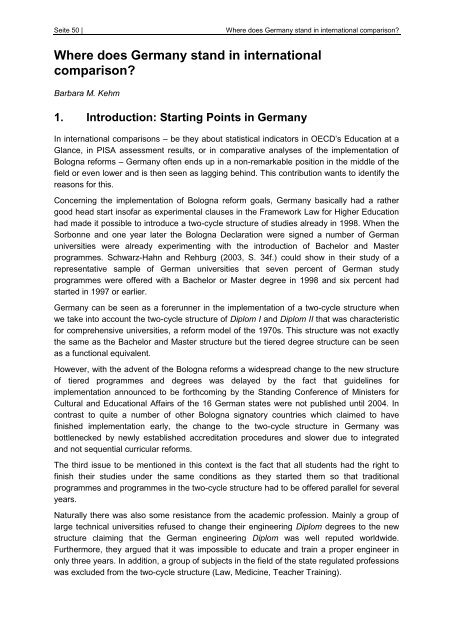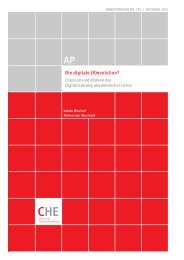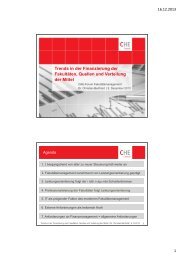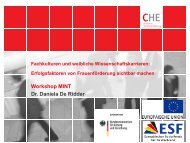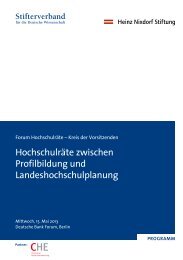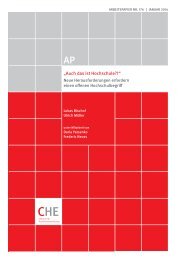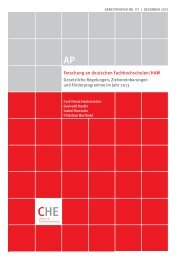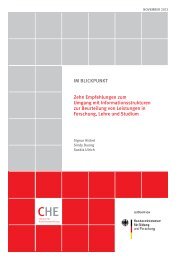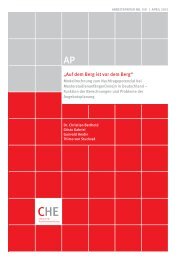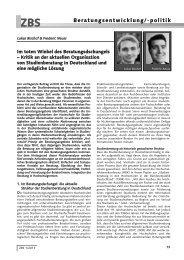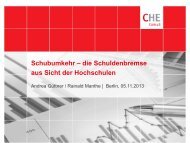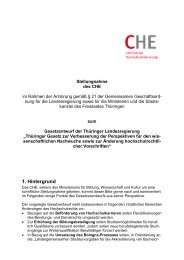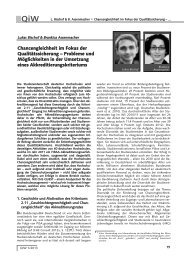Der Bologna-Prozess aus Sicht der Hochschulforschung
Der Bologna-Prozess aus Sicht der Hochschulforschung
Der Bologna-Prozess aus Sicht der Hochschulforschung
Erfolgreiche ePaper selbst erstellen
Machen Sie aus Ihren PDF Publikationen ein blätterbares Flipbook mit unserer einzigartigen Google optimierten e-Paper Software.
Seite 50 | Where does Germany stand in international comparison?<br />
Where does Germany stand in international<br />
comparison?<br />
Barbara M. Kehm<br />
1. Introduction: Starting Points in Germany<br />
In international comparisons – be they about statistical indicators in OECD‟s Education at a<br />
Glance, in PISA assessment results, or in comparative analyses of the implementation of<br />
<strong>Bologna</strong> reforms – Germany often ends up in a non-remarkable position in the middle of the<br />
field or even lower and is then seen as lagging behind. This contribution wants to identify the<br />
reasons for this.<br />
Concerning the implementation of <strong>Bologna</strong> reform goals, Germany basically had a rather<br />
good head start insofar as experimental cl<strong>aus</strong>es in the Framework Law for Higher Education<br />
had made it possible to introduce a two-cycle structure of studies already in 1998. When the<br />
Sorbonne and one year later the <strong>Bologna</strong> Declaration were signed a number of German<br />
universities were already experimenting with the introduction of Bachelor and Master<br />
programmes. Schwarz-Hahn and Rehburg (2003, S. 34f.) could show in their study of a<br />
representative sample of German universities that seven percent of German study<br />
programmes were offered with a Bachelor or Master degree in 1998 and six percent had<br />
started in 1997 or earlier.<br />
Germany can be seen as a forerunner in the implementation of a two-cycle structure when<br />
we take into account the two-cycle structure of Diplom I and Diplom II that was characteristic<br />
for comprehensive universities, a reform model of the 1970s. This structure was not exactly<br />
the same as the Bachelor and Master structure but the tiered degree structure can be seen<br />
as a functional equivalent.<br />
However, with the advent of the <strong>Bologna</strong> reforms a widespread change to the new structure<br />
of tiered programmes and degrees was delayed by the fact that guidelines for<br />
implementation announced to be forthcoming by the Standing Conference of Ministers for<br />
Cultural and Educational Affairs of the 16 German states were not published until 2004. In<br />
contrast to quite a number of other <strong>Bologna</strong> signatory countries which claimed to have<br />
finished implementation early, the change to the two-cycle structure in Germany was<br />
bottlenecked by newly established accreditation procedures and slower due to integrated<br />
and not sequential curricular reforms.<br />
The third issue to be mentioned in this context is the fact that all students had the right to<br />
finish their studies un<strong>der</strong> the same conditions as they started them so that traditional<br />
programmes and programmes in the two-cycle structure had to be offered parallel for several<br />
years.<br />
Naturally there was also some resistance from the academic profession. Mainly a group of<br />
large technical universities refused to change their engineering Diplom degrees to the new<br />
structure claiming that the German engineering Diplom was well reputed worldwide.<br />
Furthermore, they argued that it was impossible to educate and train a proper engineer in<br />
only three years. In addition, a group of subjects in the field of the state regulated professions<br />
was excluded from the two-cycle structure (Law, Medicine, Teacher Training).


